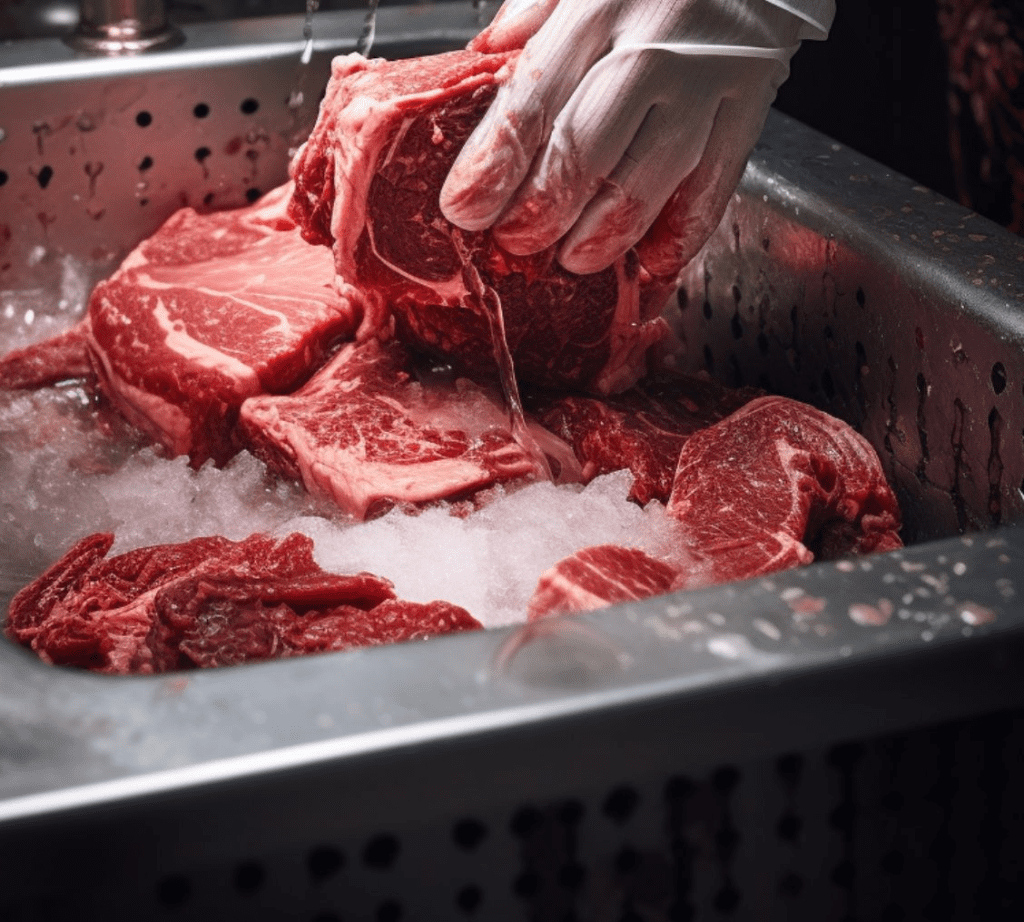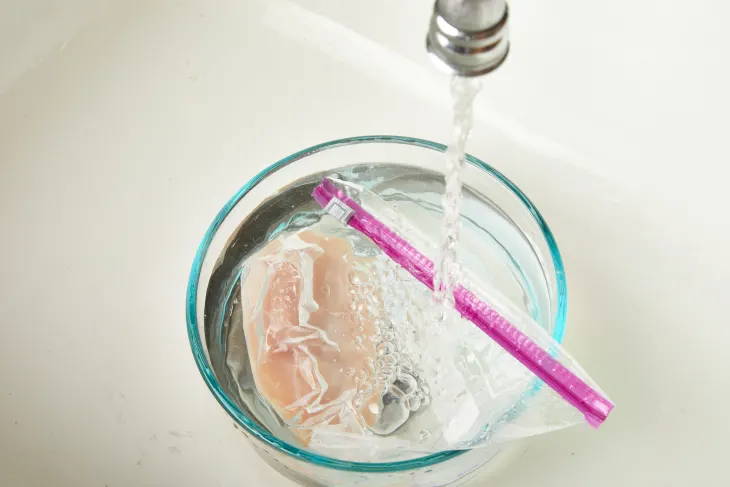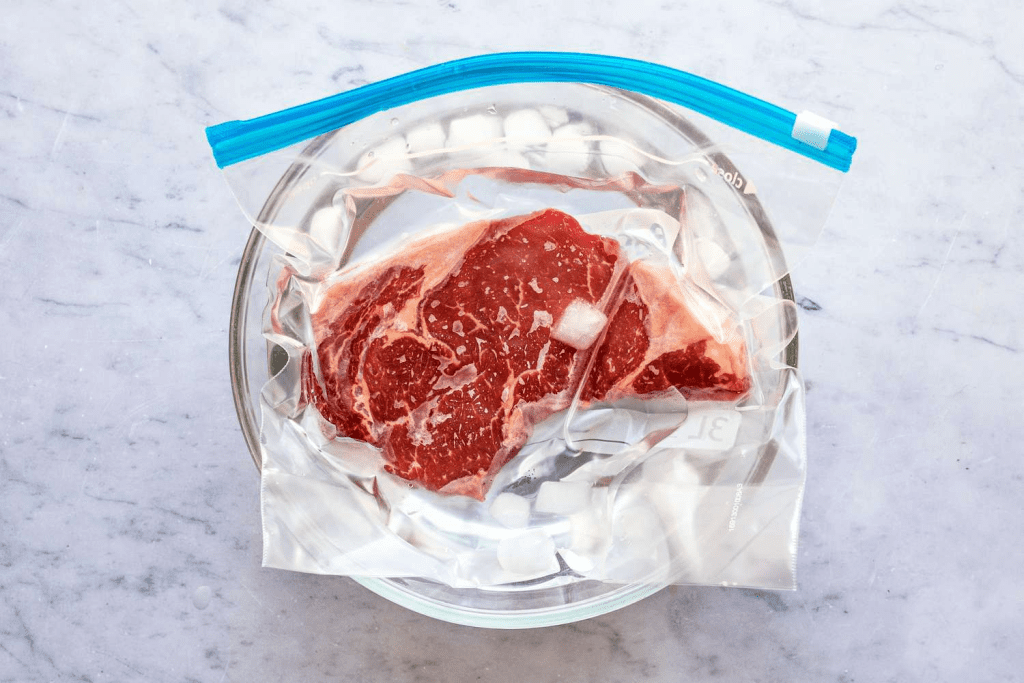Defrosting meat is a routine kitchen task, but it’s one that should be done with care to avoid foodborne illnesses. One common question that arises is whether it’s safe to defrost meat in hot water. There’s a lot of conflicting information about this method, and it’s essential to have a clear understanding to protect your health. In this article, we’ll dive into the risks, explore better alternatives, and give you the best advice on how to defrost meat safely.

The Dangers of Defrosting Meat in Hot Water
It might seem like a quick fix to defrost your meat in hot water when you’re pressed for time. However, this method comes with significant risks. The main issue? Hot water can bring your meat into the “danger zone”—a temperature range where harmful bacteria can multiply rapidly.
The Science of the Danger Zone
The danger zone refers to temperatures between 40°F and 140°F, which are ideal for bacteria like Salmonella and E. coli to thrive. When you place meat in hot water, the outer layer can quickly rise to these temperatures, even if the center remains frozen. This is a problem because bacteria can begin to grow on the surface long before the meat is cooked.
The general rule of thumb is that food should not be left in the danger zone for more than two hours. Hot water speeds up this process, and meat can become unsafe before you even realize it.
Uneven Thawing and Bacterial Growth
Another concern with using hot water is uneven thawing. The exterior of the meat can reach temperatures suitable for bacterial growth, while the inside stays frozen. This creates a perfect environment for bacteria to multiply. Worse still, once these bacteria grow, cooking the meat may not eliminate all the risks. Some harmful microorganisms, like certain strains of bacteria, produce toxins that are not destroyed by heat.
The Risk of Inconsistent Water Temperature
Hot water, while seemingly quick, doesn’t maintain a consistent temperature. Once you place the frozen meat into the water, the temperature drops, leading to uneven thawing. This fluctuation can make it hard to guarantee that the entire piece of meat stays out of the danger zone, increasing the chances of bacterial contamination.
Safer Alternatives for Defrosting Meat
If hot water is not a safe option, what are the alternatives? Fortunately, there are safer methods that food safety experts recommend. Let’s look at some of the best practices for defrosting meat while minimizing the risk of contamination.
Refrigerator Thawing: The Gold Standard
The safest way to defrost meat is by using your refrigerator. While this method takes longer—often 24 hours or more for larger cuts—it ensures that the meat stays out of the danger zone. The controlled cold temperature of the fridge keeps bacteria at bay, and the meat can stay safely stored for an additional one to two days after defrosting.
If you know you’ll need to defrost meat, planning ahead with refrigerator thawing is the best option for food safety.

Cold Water Thawing: A Faster, Safe Alternative
If you don’t have a full day to wait, cold water thawing is a faster option that’s still relatively safe when done correctly. Here’s how it works:
- Place the meat in a leak-proof plastic bag to prevent water from coming into contact with the food, which could introduce bacteria.
- Submerge the bag in cold water.
- Change the water every 30 minutes to ensure it remains cold.
This method can thaw smaller cuts of meat in as little as an hour, while larger cuts may take a few hours. However, it’s important to cook the meat immediately after thawing to prevent any bacteria from developing.
Microwave Thawing: Quick but Cautionary
For those in a real hurry, using the microwave is an option, though it comes with its own set of risks. Microwaves can cause uneven heating, which might start cooking some parts of the meat while other sections remain frozen. This creates areas where bacteria can thrive.
If you choose to defrost meat in the microwave, make sure to cook it immediately after thawing to ensure that any bacteria are killed during the cooking process. Keep in mind that microwaving might also affect the texture of the meat, so it’s not ideal for every type of dish.
Key Points to Remember for Safe Defrosting
When it comes to defrosting meat, safety should always be your priority. Here are the most important takeaways to keep in mind:
- Avoid the danger zone: Keep your meat out of the 40°F to 140°F temperature range for prolonged periods.
- Plan ahead: Refrigerator thawing is the safest method, even though it takes time.
- Cold water is a faster alternative: Make sure to follow the proper steps and change the water frequently.
- Use caution with microwaves: If you’re in a pinch, the microwave can work, but be mindful of uneven thawing and cook the meat right away.

Why Hot Water Isn’t Worth the Risk
While hot water may seem like a quick and easy solution, it’s simply not worth the health risks. The potential for bacterial growth and uneven thawing far outweighs any convenience it may offer. Instead, stick with the safer methods like refrigerator or cold water thawing.
By understanding the risks and opting for safer alternatives, you can protect yourself and your family from harmful bacteria that could lead to foodborne illnesses. A little extra time and effort can ensure that your meals are both delicious and safe to eat.
Conclusion
In the kitchen, food safety should never be an afterthought—especially when it comes to defrosting meat. While using hot water might seem tempting in a time crunch, it significantly increases the risk of bacterial contamination. Sticking to tried-and-true methods like refrigerator thawing, cold water thawing, or even using the microwave (with caution) can help you avoid foodborne illness.
In the end, the best way to ensure your meat is safe to eat is by keeping it out of the danger zone and cooking it properly once it’s thawed. So, next time you’re in a hurry, resist the urge to defrost your meat in hot water and choose a safer alternative instead.


